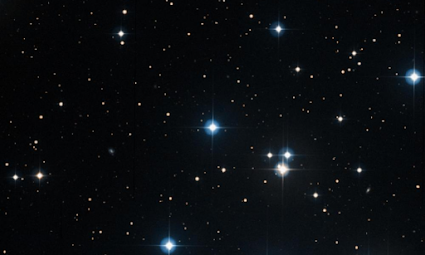Imagine a cosmic beehive, a vibrant swarm of stars buzzing with secrets from our galaxy's past. This isn't a whimsical fantasy; it's the very real Beehive Cluster, also known by its ancient Roman name, Praesepe, meaning "manger." For millennia, skywatchers have marveled at this fuzzy patch of light in the constellation Cancer, but beneath its unassuming glow lies a treasure trove waiting to be unlocked.
A Celestial Jewel Box Within Reach
Unlike distant, elusive star clusters, Praesepe boasts a remarkable distinction – it's one of our closest galactic neighbors, residing a mere 577 light-years away. This makes it a gem readily observable to the naked eye under dark skies, appearing as a faint, hazy patch three times wider than the full Moon.
Its accessibility has made Praesepe a target for astronomical scrutiny for centuries. Early astronomers like Ptolemy documented its presence in the 2nd century AD, while Galileo Galilei himself turned his revolutionary telescope towards it, ushering in a new era of celestial exploration.
A Stellar Family Portrait
Praesepe is a haven for stars, estimated to house around 1,000 celestial residents. Unlike the scattered stars across the night sky, these share a common origin, birthed from a giant cloud of gas and dust roughly 670 million years ago. This shared birthday makes Praesepe a valuable tool for studying stellar evolution – a celestial family portrait where we can witness stars at various stages of their lives.
Sun-like stars take center stage in this stellar family, offering a glimpse into how our own Sun might have looked millions of years ago. But the cast doesn't stop there. Praesepe boasts cooler, fainter red dwarfs and even a few brighter giants, allowing astronomers to trace the life cycle of stars from their fiery beginnings to their eventual demise.
A Buzzing Discovery: Exoplanets in the Beehive
While individual stars within Praesepe might not have catchy names, recent discoveries have added an exciting chapter to its story. Astronomers have confirmed the presence of exoplanets – planets orbiting stars outside our solar system – within the cluster. This is a significant find because it allows us to study planetary systems around Sun-like stars in a cluster environment.
One such example is the 42 Cancri system, home to the first confirmed exoplanet discovered within a stellar cluster. This hot Jupiter, aptly named 42 Cancri e, is a gas giant orbiting much closer to its star than any planet in our solar system. Other exciting discoveries include the EPIC 211964830 system with two mini-Neptune exoplanets and several other stars harboring confirmed exoplanets detected by the Kepler Space Telescope.
A Celestial Dance: Unveiling Praesepe's Secrets
Praesepe is not a static collection of stars. Its members are constantly on the move, slowly drifting apart due to their gravitational interactions. Over vast timescales, this expansion will eventually dissolve the cluster entirely. Studying these stellar motions allows astronomers to understand the cluster's history and predict its future.
Furthermore, Praesepe serves as a snapshot of stellar evolution. By observing the various stars within the cluster, astronomers can piece together the different stages a star undergoes throughout its lifetime. The presence of young, hot stars alongside cooler, older stars provides a valuable timeline for stellar development.
A Stellar Nursery Revisited?
While Praesepe is considered a mature open cluster, the possibility of ongoing star formation can't be entirely ruled out. The vastness of space might still harbor small pockets of gas and dust within the cluster that could fuel some limited star formation. However, this would likely be a much slower process compared to the initial burst that created the cluster millions of years ago.
Future advancements in astronomical observation techniques, particularly those that can detect faint or obscured regions of gas and dust, might shed more light on any potential low-level star formation activity within Praesepe.
A Glimpse into the Milky Way's Past
Studying Praesepe offers more than just insights into stellar evolution. By analyzing the cluster's composition and dynamics, astronomers can gain valuable information about the Milky Way galaxy itself. Open clusters are like galactic building blocks, and understanding their formation and evolution helps us piece together the history and structure of our home galaxy.
Unveiling the Secrets: Observing Praesepe
For astronomy enthusiasts eager to witness the Beehive Cluster firsthand, a dark sky location and a little patience are all you need. During the late winter and spring months (from roughly December to May, depending on your location), locate the constellation Cancer. Look for the bright stars Pollux and Castor, and then slightly to the east, you'll find Praesepe as a faint, hazy patch.


Comments
Post a Comment